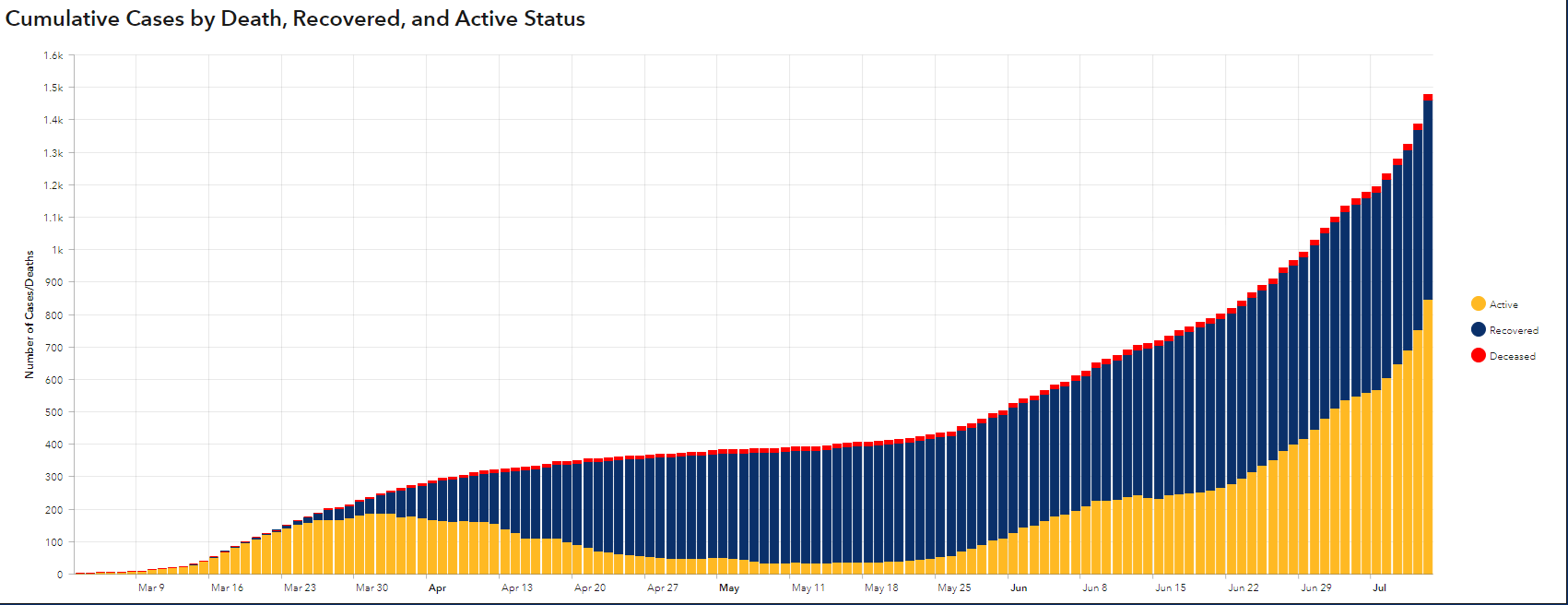COVID-19 Alaska Clinical Update, July 13
Alaska DOH sent this bulletin at 07/13/2020 06:58 AM AKDT
Monday, July 13, 2020

|
Endotheliopathy
A Yale cross-sectional exploratory analysis examined a variety of endothelial cell and platelet function biomarker levels in 48 ICU and 20 non-ICU hospitalized patients, the latter of whom were on no more than 3L supplemental oxygen. ICU patients had significantly elevated biomarkers, most notably von Willebrand Factor antigen (mean 565% in ICU patients, 278% in non-ICU patients), reference 62-175%, p=<0.0001 and soluble P-selectin (15.9ng/mL vs 11.2ng/mL), reference 8.5-11.3, p=0.0014. Both subsets of patients had D-dimers well in excess of normal, with ICU patients having an average D-dimer of 4.2 (2.6-6.9), non-ICU patients averaged 0.7 (0.4-1.2), with reference range <0.55, p=<0.0001. Mortality was significantly correlated with VWF antigen (r=0.38, p=0.0022) and soluble thrombomodulin (r=0.38, p=0.0078). The finding that soluble thrombomodulin, an endothelial transmembrane protein released on endothelial disruption or injury, correlates with mortality supports the hypothesis that endothelial dysfunction plays a significant role in severe COVID-19. The study also found antifibrinolytic alpha2-antiplasmin activity and endogenous anticoagulants (antithrombin, protein C, protein S) were not significantly abnormal, suggesting the coagulopathy in COVID-19 is not primarily consumptive; a lack of thrombopenia had previously been observed. The endotheliopathy described here and seen in autopsies may contribute to the reports of relatively frequent pulmonary emboli and stroke in relatively young patients with COVID-19, a hypothesis which is discussed in more detail in this accompanying short review article.
The evidence behind masking
A patient with COVID-19 and cough flew from China to Toronto on a jet with 350 passengers, who were monitored and none were found to have acquired COVID-19 during the flight, which was partially attributed to the patient wearing a mask. Two hair stylists in Missouri with the virus had contact with a total of 140 customers and 6 coworkers before quarantine. None of them acquired COVID-19, which was attributed to the stylists wearing masks and practicing physical distancing when possible.
Cloth face coverings are recommended for the public to prevent droplet spread of symptomatic or asymptomatic COVID-19 when around people who are not household members. Homemade cotton masks significantly reduce the amount of virus people release when they cough; replicated in other studies and also seen with surgical masks. The World Health Organization recommends public masking in an influenza pandemic and funded a study published in the Lancet which found masks combined with physical distancing and eye protection to be significantly beneficial to control transmission. Some countries had success “flattening the curve” after using public facemasks as one of several strategies to reduce transmission, and one model suggests even with conservative assumptions, each person who chooses to wear a mask may save the US thousands of dollars on average in costs associated with COVID-19 infections. Masks are also thought to contribute to decreasing transmission during the SARS epidemic. Masks also remind people not to touch their face and signal that this is not “business as usual”. A thorough long-form review article is available here.
Homemade masks help the public reduce their risk of spreading virus, along with social distancing and hand hygiene, without depleting the supply of masks for healthcare workers. Other common household materials may be used. The CDC suggests bandanas or scarves. A Hong Kong taskforce even tested paper towel masks, citing a similar structure under electron microscopy of paper towel and surgical mask material.
Sample recommendations for patients:
-Touch masks only with clean hands
-Wash hands after touching a mask
-Avoid touching your face or mask; do not pull masks down under the chin as this can contaminate the face
-Masks should be washed in hot water before the next wear
-Any surface that the mask touches should be washed
-Masks should be worn for a maximum of one day before laundering, and should be changed if they become noticeably wet or soiled since this can increase fabric permeability
-Masks should not be shared between people. If they must be shared among a family that lives together, they must be laundered in between.
-Wear masks any time you leave your home and keep them on until you return
-Don’t forget that masks cannot replace social distancing, handwashing or other measures to prevent the spread of disease. We cannot relax those other measures now.
-Anyone with respiratory symptoms must stay home regardless of whether they wear a mask, although they should be encouraged to wear a mask at home to avoid infecting the people they live with.
Masks should not be used by children under age 2, anyone who is unconscious, incapacitated or otherwise unable to remove their face covering, or anyone with significant difficulty breathing. Face coverings with clear windows are widely available to facilitate communication, particularly with people who rely on lip reading.
Alaska-specific material for patient education is available on the DHSS website, while CDC guidelines are hosted here.
|
